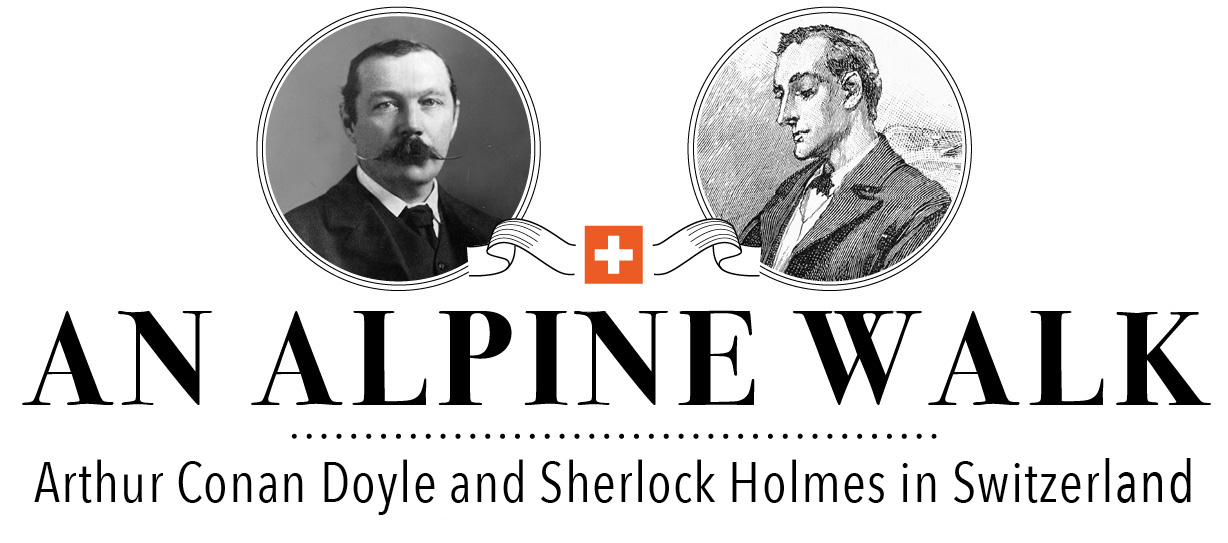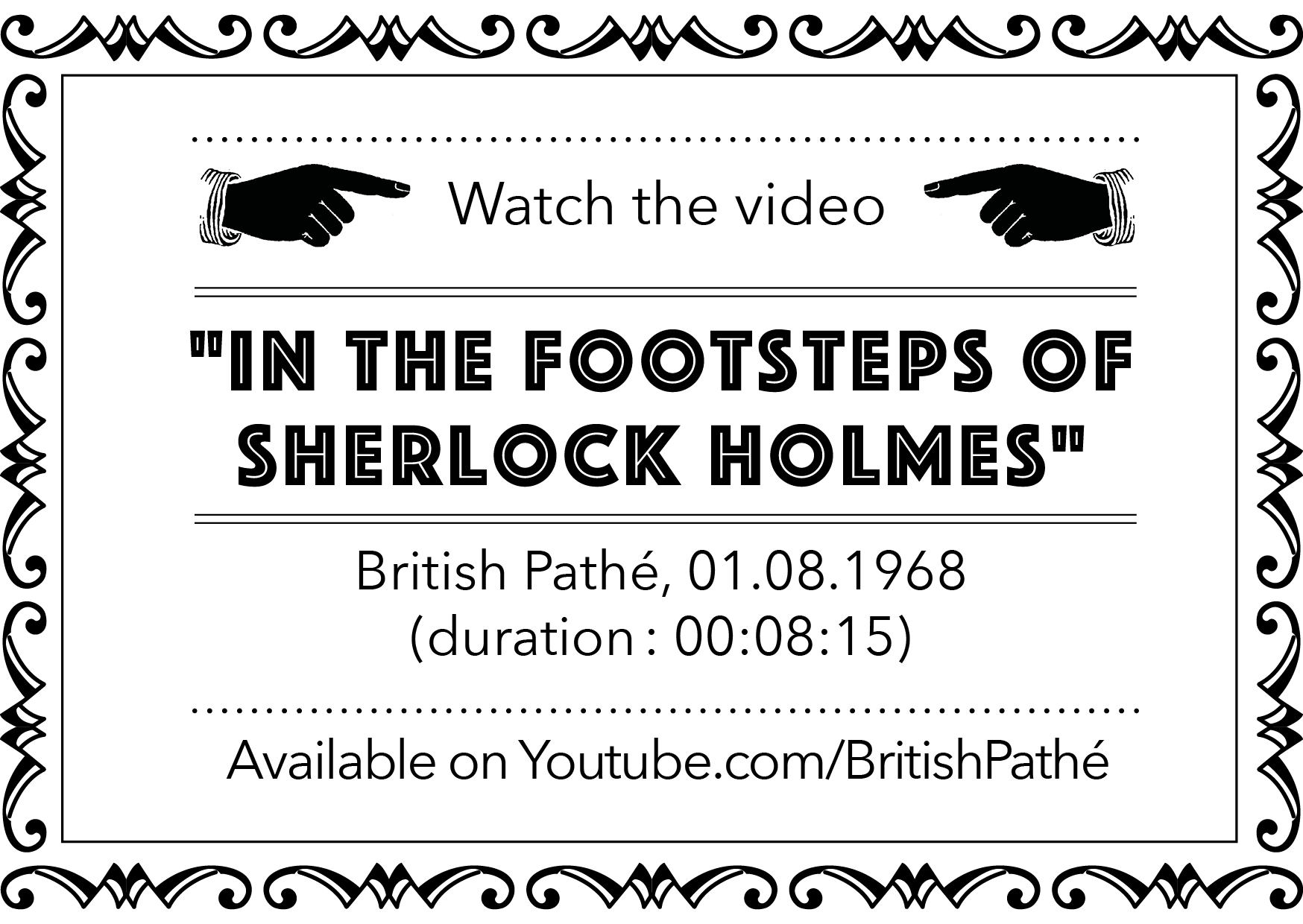Drama at the Reichenbach falls
In 1893, tired of Sherlock Holmes, Arthur Conan Doyle plans the death of his detective. This concern lingers with him during his trip to Switzerland, where the scenery proves to be a source of inspiration as to the means of staging that disappearance, which will be theatrical and resounding.
A premeditated murder
“ It is, indeed, a fearful place. The torrent, swollen by
the melting snow, plunges into a tremendous abyss,
from which the spray rolls up like the smoke from a burning house. „
Arthur Conan Doyle, The Adventure of the Final Problem (1893)
“ I am in the middle of the last Holmes story, after which the gentleman vanishes, never never to reappear. I am weary of his name „ writes Arthur Conan Doyle to his mother in April 1893. After having written 2 novels and 23 short stories about Sherlock Holmes, the author decides to get rid of his character who, he thinks, prevents him from writing more worthy literature, especially historical novels ; the idea of being known solely as the creator of Sherlock Holmes does not appeal to him.
A carefully planned scheme
The life of the detective has been hanging in the balance since the year before, as his creator was already thinking of making an end of him. At that time Holmes was eventually saved by Conan Doyle’s mother, who was able to dissuade her son from executing his project. But it was only temporary for, in the following year, the destiny of the detective was sealed.
During his sojourn in Switzerland in 1893, Arthur Conan Doyle is preoccupied with the idea of getting rid of Holmes. But even though his mind is made up about putting an end to the detective, he still has to decide the means by which he will kill his creation. During an excursion on the Findelen glacier, he mentions his sinister project to Silas Hocking. Although surprised by the news of the impending doom lurking above the detective’s head – a character who, he points out, has made Conan Doyle’s fortune – Silas Hocking is nevertheless quick to offer an idea to the writer : he suggests bringing the detective to Switzerland and making him disappear into a crevasse. Not only would it be irreversible, but also economical, for it would dispense with the costs of a funeral.
A theatrical disappearance
If Conan Doyle appreciates the idea, he eventually favours another solution. In an interview for the journal Tit-Bits, he says : “ I was in Switzerland for the purpose of giving a lecture at the time when I was thinking out the details of the final story. I was taking a walking tour through the country, and I came to a waterfall. I thought if a man wanted to meet a gaudy kind of death that was a fine romantic place for the purpose „.
The Reichenbach falls, in the Bernese Oberland, are therefore chosen to form the theatre in which the – as then supposed – final act of Sherlock Holmes will take place : his last fight with his arch enemy Professor Moriarty, which will result in the disappearance of the two adversaries in the abyss.
This story, which will be entitled The Adventure of the Final Problem, is published in The Strand Magazine in December 1893 and seems to mark a definite end to the detective’s career. His deed accomplished, Arthur Conan Doyle writes in his journal these two simple words : “ Killed Holmes ”.
“ The news of the death of Sherlock Holmes has been received with most widespread regret, and readers have implored us to use our influence with Mr. Conan Doyle to prevent the tragedy being consummated. We can only reply that we pleaded for his life in the most urgent, earnest, and constant manner. Like hundreds of correspondents,we feel as if we had lost an old friend whom we could ill spare. ”
“The Death of Sherlock Holmes”, Tit-Bits, 6 January 1894
“The Death of Sherlock Holmes”, illustration by Sidney Paget for The Adventure of the Final Problem (Wikimedia Commons)
“ I thought if a man wanted to meet a gaudy kind of death that was a fine romantic place for the purpose. ”
Arthur Conan Doyle, “A Gaudy Death. Conan Doyle tells the True Story of Sherlock Holmes’s end”, Tit-Bits, 15 December 1900
Sherlock Holmes in Le Chien des Baskerville (Raymond Pallier, Le Petit Journal Illustré, 29 January 1922)
Between 1921 and 1923, British actor Eille Norwood (1861-1948) played the part of Sherlock holmes in 45 episodes and 2 silent movies produced by Stoll Pictures. The picture above is from the adaptation of The Adventure of the Final Problem (1923), with Hubert Willis as Watson and Percy Standing as Professor Moriarty (BCU-Lausanne, IS 4314/1/5/2). The British Film Institute has been undertaking the restoration of all of the Eille Norwood movies, a project due to end in 2023.
The author pleads justifiable homicide in self-defence
Doctor Watson is not the only one by far to grieve at the loss of the detective, whom he considers, in a last act of homage, “ the best and wisest man „ he has ever known (The Adventure of the Final Problem). The readers who have faithfully followed the adventures of Sherlock Holmes in The Strand Magazine since 1891 are taken aback. Arthur Conan Doyle receives letters from his outraged public and hears echoes of their dismay, but this does not seem to be of great concern to him : “ I fear I was utterly callous myself, and only glad to have a chance of opening out into new fields of imagination „ he wrote in his autobiography.
Thus, despite the indignation of the public who refuse to believe that this disappearance is definitive, Conan Doyle persists : he has no intention of bringing Holmes back. “ I have been much blamed for doing that gentleman to death, but I hold that it was not murder, but justifiable homicide in self-defence, since, if I had not killed him, he would certainly have killed me „. It must be said that the writer has, at that time, other preoccupations. His father, Charles Altamont Doyle, has died a few months earlier, in October 1893, and the health of his wife Louise is beginning to deteriorate.
In the Footsteps of Sherlock Holmes
When Arthur Conan Doyle chooses Switzerland as the place where Sherlock Holmes will disappear, he indirectly makes the Reichenbach falls a destination for Holmesian pilgrims worldwide. The mention, in the short story The Adventure of the Final Problem, of some Swiss regions through which the detective and Doctor Watson travel will notably form the basis of colourful pilgrimages organised by the Sherlock Holmes Society of London.
The first Holmesian pilgrimage in Switzerland organized by the Sherlock Holmes Society of London occurred in 1968 and was entitled In the Footsteps of Sherlock Holmes. For this eight day trip in Switzerland, about thirty members of the Society came from London, dressed as Victorian ladies and gentlemen. For the occasion each of the participants assumed the part of a character from the Sherlock Holmes stories, for a sojourn that would lead them to Geneva, Lausanne, Lucens, Sion, Interlaken, Meiringen, Lucerne, Davos, Arosa and Zürich.
Accompanied by Swiss and foreign media – also dressed up in Victorian style – they were also followed by British Pathe, who produced a colour documentary of this trip. The pilgrimage received media coverage through press, television and radio, and this unusual trip, organised in partnership with the Swiss Tourist Office, was indeed an original advertisement for Switzerland. Since then, other similar pilgrimages of the Sherlock Holmes Society of London have taken place, always organised by Albert Kunz.
“Walking in the Alps” (by courtesy of The Sherlock Holmes Society of London)
“The departure from the Swiss Centre is a great attraction for the media” (by courtesy of The Sherlock Holmes Society of London). The start of the trip was made from the Swiss Centre in London, a building dedicated to the promotion of Switzerland and its products, hosting among others the Office National Suisse du Tourisme (ONST), shops, restaurants and even a bank. Opened in 1968, it was eventually demolished in 2008.
“Moriarty (Charles Scholefield approaches, but Holmes (Paul Gore-Booth) is resolute” (by courtesy of The Sherlock Holmes Society of London)
“Adrian Conan Doyle, Tony Howlett and Albert Kunz” (by courtesy of The Sherlock Holmes Society of London). On Sunday 28 April, the members of the Sherlock Holmes Society of London visited the castle of Lucens, and were welcomed by Adrian Conan Doyle, son of Arthur Conan Doyle and owner of the place.
Theft at the Hôtel des Bergues !
The necklace of the famous opera singer Irene Adler, a priceless gift from the king of Bohemia, disappears the very night of the Sherlock Holmes Society of London’s arrival in Geneva ! The theft occurs during the evening meal at the Hôtel des Bergues.
All of this is, of course, an incident specially organised for the occasion and the event, broadcast live on the radio, is an opportunity for the guests and the listeners to practice their detecting skills in unravelling this mystery. Eventually, the culprit – who turns out to be the king of Bohemia himself ! – is exposed by Sherlock Holmes and the precious necklace is given back to Irene Adler.
This video (soundless) from the regional television program “Carrefour” (1961-1973) shows at 8:10 the disappearance of the necklace belonging to Irene Adler (Dominique Joos). One can then see the king of Bohemia (Michael Hardwick) search Colonel Moran (Lord Donegall) with more or less thoroughness. At the end, Sherlock Holmes (Anthony Howlett) points at the real culprit.
Next chapter (3/6) →
← Previous chapter (1/6)














